Mirage
A mirage is a naturally occurring optical phenomenon in which light rays bend via refraction to produce a displaced image of distant objects or the sky.[1] The word comes to English via the French mirage, from the Latin mirari, meaning "to look at, to wonder at".[2]
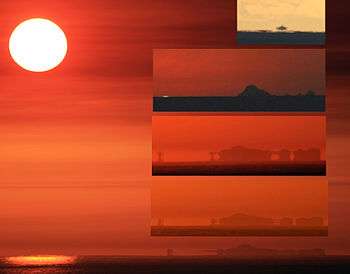
Mirages can be categorized as "inferior" (meaning lower), "superior" (meaning higher) and "Fata Morgana", one kind of superior mirage consisting of a series of unusually elaborate, vertically stacked images, which form one rapidly changing mirage.
In contrast to a hallucination, a mirage is a real optical phenomenon that can be captured on camera, since light rays are actually refracted to form the false image at the observer's location. What the image appears to represent, however, is determined by the interpretive faculties of the human mind. For example, inferior images on land are very easily mistaken for the reflections from a small body of water.
Inferior mirage
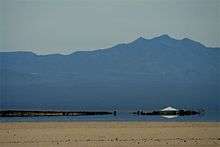
An inferior mirage is one in which the mirage image appears to be located below the real object. The real object in an inferior mirage is the (blue) sky or any distant (therefore bluish) object in that same direction. The mirage causes the observer to see a bright and bluish patch on the ground.
Light rays coming from a particular distant object all travel through nearly the same air layers and all are bent over about the same amount. Therefore, rays coming from the top of the object will arrive lower than those from the bottom. The image usually is upside down, enhancing the illusion that the sky image seen in the distance is really a water or oil puddle acting as a mirror.
Inferior images are not stable. Hot air rises, and cooler air (being more dense) descends, so the layers will mix, giving rise to turbulence. The image will be distorted accordingly. It may be vibrating; it may be vertically extended (towering) or horizontally extended (stooping). If there are several temperature layers, several mirages may mix, perhaps causing double images. In any case, mirages are usually not larger than about half a degree high (same apparent size as the sun and moon) and from objects only a few kilometers away.
Heat haze
Heat haze, also called heat shimmer, refers to the inferior mirage experienced when viewing objects through a layer of heated air; for example, viewing objects across hot asphalt or through the exhaust gases produced by jet engines. When appearing on roads due to the hot asphalt, it is often referred to as a highway mirage.
Convection causes the temperature of the air to vary, and the variation between the hot air at the surface of the road and the denser cool air above it creates a gradient in the refractive index of the air. This produces a blurred shimmering effect, which affects the ability to resolve objects, the effect being increased when the image is magnified through a telescope or telephoto lens.

Light from the sky at a shallow angle to the road is refracted by the index gradient, making it appear as if the sky is reflected by the road's surface. The mind interprets this as a pool of water on the road, since water also reflects the sky. The illusion fades as one gets closer.
On tarmac roads it may look as if water, or even oil, has been spilled. These kinds of inferior mirages are often called "desert mirages" or "highway mirages". Both sand and tarmac can become very hot when exposed to the sun, easily being more than 10 °C hotter than the air one meter above, enough to create conditions suitable for the formation of the mirage.
Heat haze is not related to the atmospheric phenomenon of haze.
Superior mirage
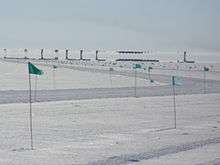
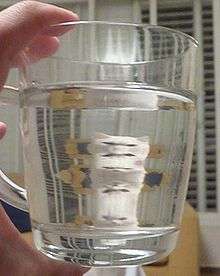
An superior mirage is one in which the mirage image appears to be located above the real object. A superior mirage occurs when the air below the line of sight is colder than the air above it. This unusual arrangement is called a temperature inversion, since warm air above cold air is the opposite of the normal temperature gradient of the atmosphere during the daytime. Passing through the temperature inversion, the light rays are bent down, and so the image appears above the true object, hence the name superior. Superior mirages tend to be more stable than inferior mirages, as cold air has no tendency to move up and warm air has no tendency to move down.
Superior mirages are quite common in polar regions, especially over large sheets of ice that have a uniform low temperature. Superior mirages also occur at more moderate latitudes, although in those cases they are weaker and tend to be less smooth and stable. For example, a distant shoreline may appear to tower and look higher (and, thus, perhaps closer) than it really is. Because of the turbulence, there appear to be dancing spikes and towers. This type of mirage is also called the Fata Morgana or hafgerdingar in the Icelandic language.[3]
A superior mirage can be right-side up or upside down, depending on the distance of the true object and the temperature gradient. Often the image appears as a distorted mixture of up and down parts.
Since Earth is round, if the downward bending curvature of light rays is about the same as the curvature of the Earth, light rays can travel large distances, including from beyond the horizon. This was observed and documented in 1596, when a ship in search of the Northeast passage became stuck in the ice at Novaya Zemlya, above the Arctic Circle. The Sun appeared to rise two weeks earlier than expected; the real Sun had still been below the horizon, but its light rays followed the curvature of the Earth. This effect is often called a Novaya Zemlya mirage. For every 111.12 kilometres (69.05 mi) that light rays travel parallel to the Earth's surface, the Sun will appear 1° higher on the horizon. The inversion layer must have just the right temperature gradient over the whole distance to make this possible.
In the same way, ships that are so far away that they should not be visible above the geometric horizon may appear on or even above the horizon as superior mirages. This may explain some stories about flying ships or coastal cities in the sky, as described by some polar explorers. These are examples of so-called Arctic mirages, or hillingar in Icelandic.
If the vertical temperature gradient is +12.9 °C per 100 meters (where the positive sign means temperature gets hotter as one goes higher) then horizontal light rays will just follow the curvature of the Earth, and the horizon will appear flat. If the gradient is less (as it almost always is) the rays are not bent enough and get lost in space, which is the normal situation of a spherical, convex "horizon".
In some situations, distant objects can get elevated or lowered, stretched or shortened with no mirage involved.
Fata Morgana
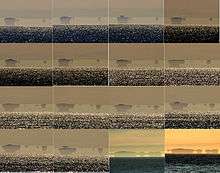
A Fata Morgana (the name comes from the Italian translation of Morgan le Fay, the fairy shapeshifting half-sister of King Arthur) is a very complex superior mirage. It appears with alternations of compressed and stretched areas, erect images, and inverted images.[4] A Fata Morgana is also a fast-changing mirage.
Fata Morgana mirages are most common in polar regions, especially over large sheets of ice with a uniform low temperature, but they can be observed almost anywhere. In polar regions, a Fata Morgana may be observed on cold days; in desert areas and over oceans and lakes, a Fata Morgana may be observed on hot days. For a Fata Morgana, temperature inversion has to be strong enough that light rays' curvatures within the inversion are stronger than the curvature of the Earth.[4]
The rays will bend and create arcs. An observer needs to be within an atmospheric duct to be able to see a Fata Morgana.[5] Fata Morgana mirages may be observed from any altitude within the Earth's atmosphere, including from mountaintops or airplanes.[6][7]
Distortions of image and bending of light can produce spectacular effects. In his book Pursuit: The Chase and Sinking of the "Bismarck", Ludovic Kennedy describes an incident that allegedly took place below the Denmark Strait during 1941, following the sinking of the Hood. The Bismarck, while pursued by the British cruisers Norfolk and Suffolk, passed out of sight into a sea mist. Within a matter of seconds, the ship re-appeared steaming toward the British ships at high speed. In alarm the cruisers separated, anticipating an imminent attack, and observers from both ships watched in astonishment as the German battleship fluttered, grew indistinct and faded away. Radar watch during these events indicated that the Bismarck had in fact made no changes of course.
Night-time mirages
The conditions for producing a mirage can occur at night as well as during the day. Under some circumstances mirages of astronomical objects and mirages of lights from moving vehicles, aircraft, ships, buildings, etc. can be observed at night.[3]
Mirage of astronomical objects
A mirage of an astronomical object is a naturally occurring optical phenomenon in which light rays are bent to produce distorted or multiple images of an astronomical object. Mirages can be observed for such astronomical objects as the Sun, the Moon, the planets, bright stars, and very bright comets. The most commonly observed are sunset and sunrise mirages.
See also
References
- Lynch, David K.; Livingston, William Charles; Livingston, William (2001-06-11). Color and Light in Nature. Cambridge University Press. ISBN 978-0-521-77504-5.
- "Definition of Mirage". Merriam-Webster. Retrieved 2019-12-08.
- David K. Lynch & William Livingston (2001). Color and Light in Nature (2nd ed.). Cambridge, UK: Cambridge University Press. p. 58. ISBN 978-0-521-77504-5.
- An Introduction to Mirages by Andy Young
- SDSU.edu, "Atmospheric Optics Glossary" by Andy Young
- Durst and Bull (1956). Met. Mag. 85. pp. 237–242.
- Andrew, Young. Annotated bibliography of mirages, green flashes, atmospheric refraction, etc.
External links
| Wikimedia Commons has media related to Mirages. |
- All kind of mirages explained
- China daily, rare mirage in Penglai
- The superior mirage
- The inferior mirage
- The highway mirage
- Fata Morgana Mirage from the Continental Divide Trail
- Bowley, Roger (2009). "Mirages". Sixty Symbols. Brady Haran for the University of Nottingham.